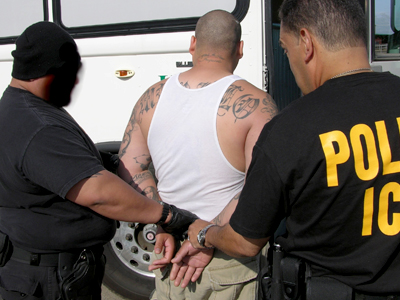
Male or female, Latinos share reasons for gang involvement ---
The at-risk neighborhoods in which many Latinos live play a pivotal role in gang activity, says new research from the Health Initiative of the Americas (HIA), School of Public Health, at UC Berkeley. The research looks at the reasons behind a high and growing rate of gang involvement among male and female Latinos.
According to researchers, violent neighborhood conditions create an environment conducive to engaging in gang activity, particularly among youth, who may consider gang involvement as a viable option for protection.
Gang affiliation among Latinos has been rising in the United States, especially among U.S.-born Latinos. The rate of incarceration of U.S.-born Latino males age 18-39 is seven times that of their foreign-born Latino counterparts. Gang involvement often leads to other risky and illegal behavior such as drug use, which starts at a younger age for Latinos than non-Latino gang members.
Mauricio Muñoz of Hayward is a former gang member and drug addict who walked away from the gang life nine years ago with the help of Victory Outreach, an international faith-based organization that helps gang members, drug addicts, alcoholics and others. From the age of fourteen, Muñoz was involved with gangs, crime, and the police. In jail or on probation constantly, his life was a destructive cycle without direction. As a gang member, he was in the line of fire and at risk of becoming another Latino gang murder statistic.
Like many young Latinos, Muñoz got involved in a gang because he believed it would offer him a sense of belonging, or provide a stronger family unit than he had at home.
"I got involved with the gang because I wanted to be part of something," he says. He believed the promises of his gang brothers when they would tell him that if he committed a certain crime the gang would take care of his family when he was in prison. Eventually he came to see the truth about the gang. "It was all a big lie," he says.
Research has shown that Latino gangs often supply emotional support and financial protection, characteristics that are lacking in many of their members’ households. Even though Latino gangs began as small organizations that were highly disorganized, the 1980s saw the systematization of gang involvement in this population and an increase in members ages from 14-20 to 12-40 years old. The networks grew from a group of boys who shared a culture, customs, and language, to groups that have identifying symbols and colors, and practice rituals for their members.
Joesy Pineda is the pastor at Victory Outreach Hayward. Beyond the universal need to belong, she sees motivations specific to Latinos. "It's the macho culture, the need to show their virility as men," she says. "They compete against each other, trying to prove themselves."
Muñoz married the mother of his children and today works as an electrician. When he visits his mother in his old neighborhood, he sees some of his former gang brothers. "They say I am an inspiration to them that they can change their lives too."
Common characteristics of gang involvement:
• Early exposure to sexual activity/abuse, early drug use, and exposure to violence.
• Low income neighborhoods and families.
• Family dysfunction.
• Lack of involvement in positive activities in and out of school.
Characteristics of male involvement:
• Up to 78% of all male gang members that are incarcerated have emotional and learning disabilities.
• The majority of those involved are low income, have a history of failure in school and truant behavior, have friends who are also delinquent, and had early involvement in petty theft and behavioral disorder in grade school.
Characteristics of female involvement:
• They often assist male gang members in the following ways:
• Carry drugs and weapons and provide safe houses for contraband;
• Engage in prostitution;
• Engage in drug sales, vandalism, and credit card and identity theft.
• Latina gangs are starting to evolve exclusive of the traditionally male-dominated Latino gangs. While the number of all-female gangs remains low, the role of women in gangs is evolving. Women are taking more active roles, assisting in the movement of drugs and weapons, and gathering intelligence from other gangs.

